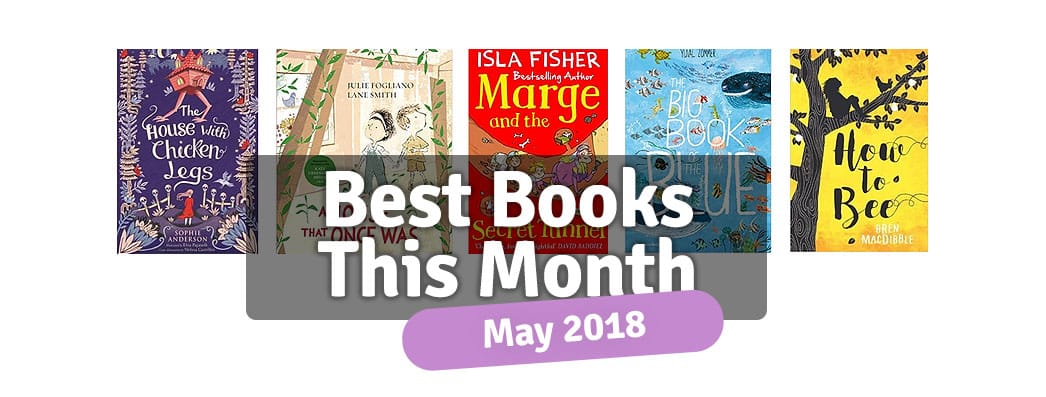It’s easy to feel lost in the flood of so many new children’s books available. Each month, we pick five of our recently published favourites.
Check out our Review Panel’s top picks for you to read in May 2018.


It’s easy to feel lost in the flood of so many new children’s books available. Each month, we pick five of our recently published favourites.
Check out our Review Panel’s top picks for you to read in May 2018.
This is a wildly imaginative and highly unusual story (in the best of ways) brimming with wonder, magic, folklore and compassion. Marinka is a 12-year-old girl who lives with her grandmother, Baba Yaga. Together they live in a house with chicken legs and move around from place to place, fulfilling their role of ‘guardians of the gate’ by guiding the spirits of the deceased through the gateway between life and death. Before the spirits pass through the gate, Baba Yaga listens to their stories and celebrates their life with them. Marinka’s destiny appears to be already decided; she is to train to become a Yaga like her grandmother and this means that she is never allowed to go to school or make friends with the living. Increasingly Marinka realises that she does not want to live the life of a Yaga and begins to take big risks as she experiences a rising desire to make some real friends and sample a ‘normal’ existence. What follows is an emotive coming-of-age story that sees Marinka working to resolve the tensions between her desires and the path she is expected to follow.
Sophie Anderson is a wonderful storyteller and has very skilfully crafted a compelling and believable magical world that is an enchanting amalgamation between traditional and modern. I really enjoyed how, through Marinka’s eyes, I found myself able to explore elements of a Slavic folk story in a fresh and relatable way, and how Anderson’s emotive narrative invites the reader to meet the characters and events with a large amount of compassion.
This is a magical and captivating narrative that dances its way through darkness and light, joy and grief and life and death and it is highly recommended for Years 5 and 6
Rhythmical and enchanting, A House that Once Was is a picture book about imagining and connecting with how things might have been different in other times. Deep in the woods two children discover an old house; “a house that once was but now isn’t a home”. The children enter the house through a broken window and it is immediately clear that the house used to be somebody’s home, as the pair discover faded pictures, empty food jars and abandoned music records. The children begin to imagine different possibilities about who the house’s former occupants could have been and where they have gone; perhaps a boy who built flying machines or a girl who has become shipwrecked on a desert island and now wears ‘coconut clothes and a pineapple tie’. After their fanciful adventures, the two children return to their own house where dinner is waiting and the rooms are cosy and warm, and unlike the house in the woods is definitely a ‘home’.
This is a wonderful book to use with KS1 for sparking discussions about how a house becomes a home and to set children off on their own imaginative adventures about who might have once inhabited the house in the woods.
Here at BooksForTopics HQ we are huge fans of Isla Fisher’s Marge in Charge books and we have been eagerly anticipating the arrival of the newest one, Marge and the Secret Tunnel. Charming, witty and full of laugh-out-loud moments, we were happy to find that the latest instalment was well worth the wait.
Jemima and her little brother Jakey always look forward to their unconventional babysitter Marge coming round to look after them. Marge has rainbow hair and doesn’t seem like other grown-ups at all, and despite Mum’s list of important rules pinned to the fridge Marge always seems to stumble into hilarious adventures.
In this collection of three Marge stories, Jemima discovers a deep hole in the garden and when Marge comes over to babysit it seems like the perfect time to explore what is inside. As usual, Marge takes on the challenge gleefully, leading the children underground and through the secret tunnel. In the later stories, the trio embark on an unusual shopping trip and an important quest to rescue the neighbour’s lost kitten.
Marge has a song for every occasion and plenty of room for imagination and creativity. These short stories are a real hoot and are just brilliant for reading aloud to children in KS1 or lower Ks2.
This large-sized informative compendium is the kind of non-fiction that children like to come back to again and again to pore over its pages. Each double-page spread dives into a different sea-themed question, such as ‘Are jellyfish made of jelly?’ or ‘Why do crabs run sideways?’. There is never too much text on each page, but what you find is accessible chunks of information cleverly interspersed into each ocean scene. The illustrations are stunning and come together to make wonderful spreads that serve as a treasure trove of visual delights for young eyes, as text and pictures work together to build an understanding of underwater habitats and the life they hold.
How to Bee is a wonderfully gripping narrative set in a dystopian future where there are no bees and children work on farms to pollinate fruit trees by hand. Fruit has become a luxury afforded only by the rich people living in big houses in the city. Out on a rural farm, nine-year-old Peony lives in poverty but is incredibly well loved by her sister and grandfather. Peony dreams of becoming one of the farm’s best ‘bees’ and tries to prove herself to the Foreman by showing him just how quickly she can run and climb, pollinating the trees by hand with her feather wand. One day Peony’s world is turned upside down when her Ma turns up at the farm and demands that Peony come to the city to work with her.
It soon becomes clear that living in a wealthy house in the city is not as idyllic as some people might think. Peony is a steely and determined protagonist and she sets about on a mission to return home to her family as soon as possible. Along the way, Peony encounters some disturbing mental and physical difficulties faced by different characters and she demonstrates heartfelt compassion and courage in trying to help other people despite her determination to escape the city as soon as possible.
This is a beautiful book that is intelligently written and incredibly moving. We highly recommend this story about family bonds, the power of hope and the importance of not losing sight of things that matter and it would make an excellent class novel for Year 5 or 6.


© BooksForTopics 2015-2024
review
Year group(s) the book is most suitable for:
Year group(s) the book is most suitable for:
Does the book contain anything that teachers would wish to know about before recommending in class (strong language, sensitive topics etc.)?
Does the book contain anything that teachers would wish to know about before recommending in class (strong language, sensitive topics etc.)?
Would you recommend the book for use in primary schools?
yes
Curriculum links (if relevant)
Curriculum links (if relevant)
Any other comments
Any other comments